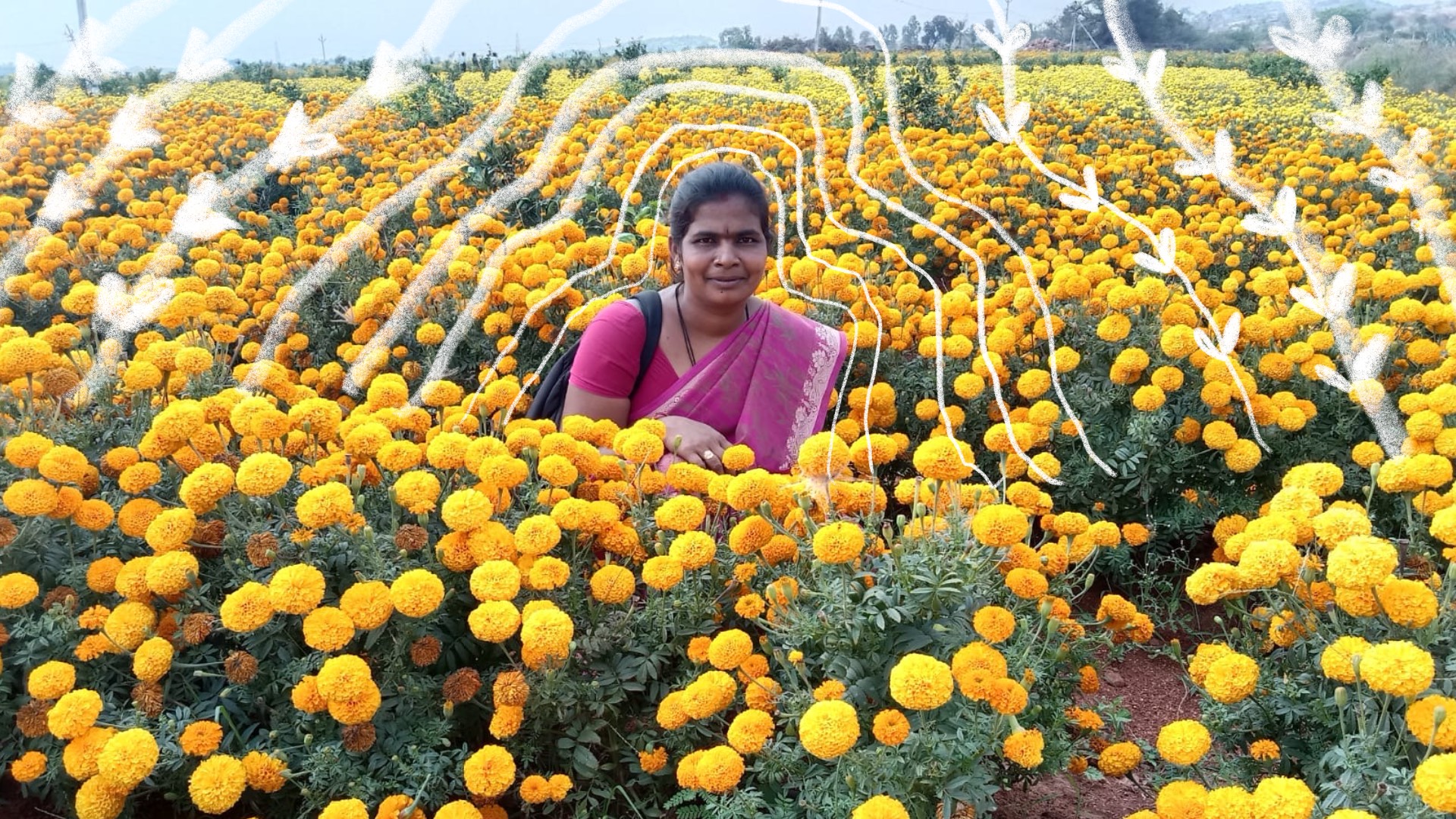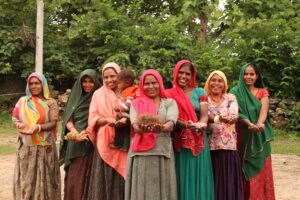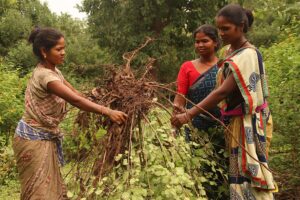Women Like Bhanumati Are Powering Andhra’s Natural Farming Model
Amid chronic drought, debt, and landlessness, women in Anantapur are using natural farming to reshape agriculture, economies, and gender roles – but face mounting challenges.
- Prudhviraj Rupavath

Nine years ago, Mutyalapati Bhanumati, 45, leased an acre of land from a local landlord to try natural farming in her village, Muchukota, in Anantpur district’s Peddapappur mandal. Her neighbours mocked her for starting what seemed like a reckless enterprise – this was after all, Rayalaseema, the drought-prone belt of Andhra Pradesh, where the average annual rainfall is 520 mm less than half of India’s average of 1,160 mm.
“Many small farmers in our district were leaving agriculture and migrating to Bengaluru city to find work as casual labour in construction and other odd jobs due to continuous droughts,” Bhanumati recalls.
Until then a homemaker from the Balija community, Bhanumati’s life revolved around caring for her elderly parents, husband and three children. So, this sudden shift to farming, and that too, natural farming seemed risky. But she says she knew what she was getting into.
“There was a government campaign in our village about the benefits of natural farming. Its cost-effectiveness model gripped me,” she told Behanbox. At the time, she anyway did not have enough money to invest in conventional farming using expensive fertilisers and pesticides. “It would cost me at least Rs 30,000 per acre to grow vegetables if I had to buy pesticides. I have also seen people in my village face losses with that kind of farming.”
Natural farming is a chemical-free, climate-resilient method that involves use of local resources like cow dung, cow urine and biomass. It reduces input costs and improves soil fertility through practices like mulching, intercropping, and microbial applications. The Indian government has been promoting this style of climate-resilient natural farming as “Zero Budget Natural Farming” since 2019-20.
Behanbox has reported extensively on the challenges and triumphs of women who engage in natural farming, especially those from marginalised and economically disadvantaged social groups. We wrote about the impoverished and arid Adivasi hamlet of Peepla in Rajsamand’s Kumbhalgarh tehsil where amidst scrub and stone women are raising local vegetables and greens using natural farming methods but only in quantities that can feed their families.
Last October, we travelled to villages in seven districts of Gujarat for a three-part series on how natural farming has helped women farmers deal with new climate realities but also how gendered land ownership patterns and non-existent support systems affected their ability to run a sustainable agri business. Natural farming is also labour intensive, we found, with long hours spent on gathering organic inputs for the farm and a wait of as many as five years for results to show up. This labour is rarely acknowledged or accounted for.
Bhanumati is among those who over nine years did manage to succeed despite several odds, as we explain later. So much so that she now owns two acres of land where she follows a multi-cropping pattern to grow vegetables, pulses, fruits and millets. She also trains others in natural farming as a senior resource person with the state-supported Andhra Pradesh Community Managed Natural Farming (APCNF), an initiative of the agriculture department’s Rythu Sadhikara Samstha (RySS).
To understand the odds stacked against Bhanumati, consider this: over the past two decades, Anantapur district has seen 17 years of drought and only three successful crop seasons, as per V Lakshma Naik, district project manager and the Chief Technology and Innovation Officer of the APCNF.
Against Odds
Bhanumati’s farm that stands in defiance of Anantapur’s hostile terrain has brought her international attention. Delegations from over 20 countries have come here to study how women can build a climate-resilient agricultural model.
But these are also stories of how women’s labour remains invisibilised, how they lack ownership and agency over the land that they till and how their access to commons and credit is under constant threat. This means that the women are not just farming, they are also rebuilding ecosystems, creating livelihoods, and pushing back against gender norms.
YV Mallareddy, director of Accion Fraterna Ecology Centre based in Anantapur, says that landowners often reclaim lands once they are rejuvenated through the labour of tenant farmers, and that village commons – essential for grazing, natural farming, and firewood – are being increasingly encroached upon by developers.
Anantapur’s terrain is marked by sparse vegetation, dry red soil, and rocky outcrops. Many of the borewells that dot the landscape have been abandoned after they dried up.
“Anantapur’s economy has long been shaped by rain-fed agriculture, but decades of recurring drought, coupled with farmers’ interest in commercial cropping, have deepened its agrarian crisis,” said Mallareddy, who has been studying agriculture in the drought-prone district for decades. He added that the push toward commercial cropping – especially groundnut and cotton – led to heavy investments in borewells, synthetic inputs, and market-linked loans. “Many farmers, in their bid to remain viable, sank borewell after borewell only to find no water,” he said.
Bhanumati’s Initiative
A typical day for Bhanumati begins before dawn, carrying a container of jeevamrutham, a natural concoction of cow dung, cow urine, jaggery, and legume flour, to her farm. She inspects the health of her crops. With no chemical inputs, she relies on mulching, hand-weeding, and bio-sprays to protect and nourish the soil. Afternoons are reserved for guiding fellow women farmers, drawing on her experience as a trainer under the APCNF programme.
Bhanumati’s journey began in 2016, at a time when successive drought cycles had left Muchukota’s fields bare. “I had seen farmers borrowing to buy fertilisers and pesticides, only to lose their crops to drought,” she said, her gaze distant. “Some couldn’t bear the debt – they took their own lives.”
As a tenant farmer, she pointed out, she could not risk such losses. Joining the APCNF as a trainee, she learned natural farming techniques – how to use cow dung, cow urine, jaggery, and neem to nourish the soil and keep off pests. “I was sceptical,” she admitted. “Could these ancient methods work when modern chemicals had failed? But I had nothing to lose.”
In a process of trial and error, she started on a small scale, planting millets and vegetables on her leased acre. But her methods proved effective. “We create organic pesticides from cow urine, dung, neem leaves, and water, fermented for a few days,” she explained. “It’s available in our village for free, unlike chemicals, and it keeps pests away without damaging the soil.”
Multi-cropping became her defence against Anantapur’s unpredictable climate. “Untimely rains used to destroy single crops, but now, with millets, vegetables, and fruits grown together, if one fails, others survive,” she said. “It’s like a safety net – some crops withstand drought, others thrive in sudden rain.”
Her farm flourished, earning praise from returning migrants: “Bhanumati polam chala bagundi (Bhanumati’s field looks great),” they would exclaim. However, her tenancy brought heartache. “I invested years into that land, and when it became productive, the owner took it back,” she said, her voice tight with disappointment. Now owning two acres, she advocates for tenant farmers’ rights.
As we have reported earlier in our investigations spanning Gujarat’s Adivasi districts, the national average for rural women’s participation in agriculture is 77.3% but only 13.9% of India’s agricultural land holdings are controlled by women, per the 2015-16 agricultural census. And the lack of land ownership has been a longstanding structural issue for women farmers, a factor that alienates them from government schemes – including those that drive its natural farming initiative – and benefits and other formal credit systems.
“Tenant farmers constitute a significant portion of cultivators facing compounded distress. Lacking formal land titles, they remain outside the ambit of most state schemes like Rythu Bharosa or PM-KISAN. Women, particularly single women or widows, are doubly disadvantaged in this land and debt-based exclusion,” said C Bhanuja, founder director of Rural Environment and Development Society, a non-profit based in Anantapur.
Although the Andhra Pradesh government acknowledges tenant farmers through Loan Eligibility Cards (LECs) as per the Andhra Pradesh Land Licensed Cultivators Act, 2011, women we interviewed said they were often denied bank credit and informal leasing arrangements. They said they had to rely on verbal agreements with landowners, who could evict them at will.
“If the landowner wants it back next season, we have no choice but to leave,” said Bhanumati, recalling her years as an insecure tenant farmer.
Bhanumati succeeded despite her systemic exclusion from formal entitlements as a tenant farmer. The inability to produce land documents denies women the right to claim damages during crop failure or to access input subsidies under schemes like Rythu Bharosa. Despite multiple applications, Bhanumati said, she was unable to secure a loan, claim compensation for crop damage caused by unseasonal rains, or receive any government benefits during her years as a tenant farmer.
A Way Out of Debt
Women farmers we interviewed said that conventional farming requires at least Rs 20,000-Rs 30,000 an acre annually with investments in fertilisers, pesticides, and borewell maintenance. Borewells, drilled to depths of 300 meters at a cost of Rs 1 to Rs 2 lakh each, and these often dry up as groundwater levels decrease, forcing farmers to borrow at 24% interest. The advantage of natural farming in this regard is that it reduces water consumption by keeping the soil moisture-rich.
“We invested Rs 1 lakh in a borewell that failed within two years,” said R Suseelamma, 42, from Kurugunta village, just 10 km from the Anantapur district headquarters. So my husband and I tried natural farming, she said. “Natural farming reduces costs – to Rs 2,000-Rs 5,000 per acre. That means no more debts,” she said.
Her family now farms on eight acres (five acres of their own land and three leased), earning Rs 50,000 to Rs 60,000 per acre annually, an increase from about Rs 30,000 with conventional methods.
“Multi-cropping means we sell millets, vegetables, fruits – something always providing an income,” she said. Bhanumati echoes this: “Before, I would lie awake worrying about money for seeds, water, chemicals. Now I’m able to save about Rs 50,000 to Rs 60,000 per acre every three months.”
Buried under a debt of Rs 2 lakh Chemili Alivelu’s husband had died by suicide nine years ago. “Chemical farming was destroying us,” recalled the farmer from Kuruganta. After joining a community farming initiative led by the Rural and Environment Development Society (REDS), a non-profit based in Anantapur, she halved her expenses and doubled her income.
This economic transformation for tenant farmers of the state is remarkable but it is limited, according to a non-profit Rythu Swarajya Vedika’s 2022 study reported by Deccan Herald. The report said that tenant farmers continue to be deeply indebted with an average debt of about Rs 2 lakh each and deal with the burden of massive rents ranging from Rs 20,000 to Rs 1.2 lakh per acre.
‘Trust The Land’
A few years ago, when she switched to natural farming methods, Suseelamma had to deal with widespread cynicism. “People laughed, calling us cattle-keepers for spraying dung and urine,” she remembered with a faint smile. “Now, they come asking how my fields stay so green.” Her eight acres, abundant with millets and fruit trees, are a proof of her labour and resilience.
Alivelu said her painstaking work helped her channel her grief into leadership. “I thought farming was cursed after my husband’s death. Now, I train 20 women in community based natural farming,” she said.
Bhanumati had trained 500 farmers in natural methods. “I teach them to trust the land,” she said, her voice filled with pride.
But natural farming is labour intensive and the hard work put in by the women farmers remains invisible, as we had reported in our stories on natural farming. It involves extensive and intensive effort in collecting, sorting, mixing, storing and using natural inputs. Some of the women farmers we interviewed for our series said that they have to let several crop cycles go before they start seeing the benefits of the natural practices and in these years, anywhere between one to five, they had to cope with hardships.
“Women’s labour drives this natural farming movement, but it’s uncounted, undervalued,” said Mallareddy.
APCNF: A Women-Led Initiative
Launched in 2016, APCNF aims to transition 8 million Andhra Pradesh households to natural farming by 2026, training women in indigenous practices through Self-Help Groups and Village Organisations.
“We empower small and marginal women farmers, especially from SC, ST, and backward communities, for ecological restoration and secure livelihoods,” said APCNF’s Lakshma Naik.
With over 350 success stories in Anantapur, the government’s natural farming programme has introduced multiple models for dryland cultivation. One is the Pre-Monsoon Dry Sowing (PMDS), where seeds are sown just before the monsoon, ensuring an early green cover, reduced soil temperature, moisture conservation, and improved soil health.
“The PMDS withstood the 2024 Fengal cyclone in Andhra Pradesh’s coastal districts, ” said Naik.
Then there is the Any Time Money (ATM) model encourages farmers to intercrop short-duration vegetables and pulses between major crops, enabling frequent harvests and steady incomes. The ‘A-Grade’ model focuses on market-linked planning—farmers are trained to grow high-demand, high-nutrition crops in a multi-cropping system, improving food security and boosting overall farm profitability.
Women trainees are also encouraged to revive traditional methods of preserving seeds of native millets such as foxtail and pearl. “My mother taught me to save seeds and mix crops; now it’s science fighting drought,” said Suseelamma.
APCNF’s climate-friendly initiatives won it the Gulbenkian Prize for Humanity two years ago. “Soon, Anantapur’s women farmers will train African farmers, sharing our models,” said Naik.
In the meanwhile, women farmers are engaged in a campaign to prevent the commercial takeover of village commons. As Bhanumati pointed out: “Without commons, natural farming weakens. These lands are our strength.”
Bhanuja, founder director of REDS, pointed out that these lands are carbon sinks, critical for climate mitigation. “But the government prioritises development,” she added, pointing out that over 50 villages face this threat. Her organisation runs extensive programmes related to women’s empowerment, natural farming, seed banks, and commons management.
In Suseelamma’s village, a plan to convert 200 acres into a housing complex threatens livelihoods. “We protested; cattle need grass, and we need wood,” Suseelamma said. Her community’s resistance has stalled the project so far.
[This story is part of a new series “Climate Leaders: Women in Local Climate Action”, a collaboration between Womanity and Behanbox.]
All the stories in the series can be read here.
We believe everyone deserves equal access to accurate news. Support from our readers enables us to keep our journalism open and free for everyone, all over the world.




